Short History of the United States Flag

The current flag of the United States is the twenty-seventh version of the national flag. When the Thirteen Colonies were seceding from the British, there became a necessity for a flag to symbolize the patriot cause and rally individuals for the Revolution.
The first “official” flag was “the Continental Colors,” also known as the “Grand Union Flag,” which consisted of thirteen red and white stripes and the United Kingdom’s flag in the upper-left-hand corner, also known as the canton. It was the same design as the flag for the British East India Company that flew from 1701 to 1801. However, the British East India Company’s flag ranged from nine to thirteen red and white stripes and was usually only flown when it was sailing in the Indian Ocean. The Continental Army flew the flag until 1777.
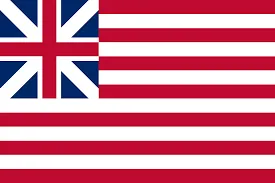
During this time, other flags were flown to show support for Independence. Christopher Gadsden designed "The Gadsden Flag" in 1775. This flag depicts a rattlesnake with the phrase “DONT TREAD ON ME” in a field of yellow. The Continental Marines used the Gadsden Flag during the early years of the war and the flag still flies today as a sign of American patriotism.
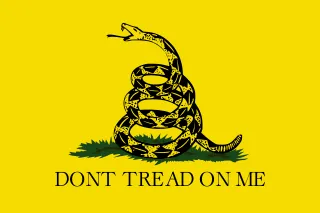
Colonel William Moultrie commissioned "The Moultrie Flag" in 1775 to prepare for war with Great Britain. It depicts a white crescent moon with the word “LIBERTY” inscribed within it on a field of navy blue. It was flown during the American victory at the Battle of Sullivan’s Island in June 1776.
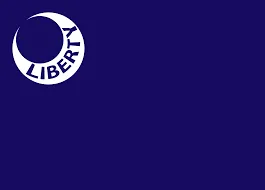
A popular belief is that Elizabeth Griscom, a Philadelphia flag maker who was also known as Betsy Ross, sewed the first “official” flag in June 1776. The legend goes that George Washington, Robert Morris, and George Ross came to Betsy Ross’s house to discuss the design of a national flag. The original design had six-sided stars representing the thirteen colonies on a field of blue with red and white stripes. She suggested a five-pointed star. The three men, amazed at how quickly she could cut the five-pointed stars, assigned her with the task of sewing the flag.
This belief originated with William J. Canby, Ross’ grandson. He presented this idea to the Historical Society of Pennsylvania in 1870 and stated that his aunt Clarissa Sydney Wilson, one of Ross’s daughters, told him the story in 1857. Ross had died twenty years prior. Today, there is no conclusive evidence supporting or denying this claim.
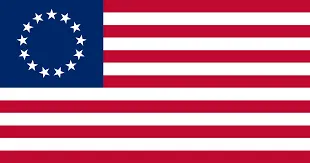
On June 14, 1777, the Second Continental Congress passed the first Flag Resolution. This resolution officially adopted the “Stars and Stripes” as the national flag and states:
Resolved That the Flag of the united states be 13 stripes alternate red and white, that the Union be 13 stars white in a blue field representing a new constellation.
June 14th is celebrated as Flag Day because of this resolution. Since the resolution did not specify the arrangements of the stars, flags exist with a variety of “constellations.” The “Betsy Ross” flag arranges the stars in a circular pattern.
Francis Hopkinson, signer of the Declaration of Independence from New Jersey, claims that he designed the “Stars and Stripes” that was designated as the national flag. The above resolution was adopted from the Marine Committee, who had been using these guidelines for flags since July 4, 1776. Francis Hopkinson was chairman of the Navy Board’s Middle Department which was under the Marine Committee at the time that these guidelines were established in 1776. On May 25, 1780, he requested a quarter cask of wine in payment for his help in designing the national flag and aiding in designing the Great Seal for the United States. After his letter went unanswered, he asked for £2,700. The Auditor General, James Milligan, and the Chamber of Accounts, investigated his claim and noted that Hopkinson was not the only person on the Navy Committee or the three Great Seal committees, so he should not singularly be called out and compensated for his work. There are no surviving illustrations of his design, but the flag most likely has 13 red and white stripes, and 13 six-pointed stars in a field of blue.
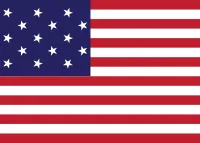
Congress did not dictate why red, white, and blue were chosen for the flag in their resolution. The only explanation given is from Charles Thompson, Secretary of the Continental Congress. On 1782, he consolidated the designs and work from the three committees tasked with creating a National Seal. No original design from Thompson exist depicting this consolidated seal, but he wrote a detailed summary including the meanings behind the colors of the United States. He stated:
The colors of the pales (the vertical stripes) are those used in the flag of the United States of America; White signifies purity and innocence, Red, hardiness & valour, and Blue, the color of the Chief (the broad band above the stripes) signifies vigilance, perseverance & justice.
In 1794, a second Flag Act was signed. In this resolution, two new stars and two more stripes were added to the design, which symbolized the addition of Vermont and Kentucky into the Union. This flag remained in use even when five more states were added to the Union. In 1818, the third Flag Act was signed that started the precedent of adding another star to the flag after each state’s entrance into the Union. In addition, this act reduced the number of stripes from fifteen to thirteen.

The current flag has fifty stars and has remained unchanged since Alaska and Hawaii entered the Union in 1959. This is the longest-used rendition of the flag.






